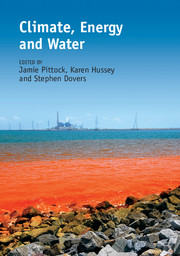Book contents
- Frontmatter
- Contents
- List of contributors
- Acknowledgements
- 1 Justifying, extending and applying “nexus” thinking in the quest for sustainable development
- 2 Water resources, climate change and energy
- 3 Implications of climate change for energy systems in a multisectoral context
- 4 Fossil fuels and water: A complex and evolving relationship
- 5 Renewable energy and water
- 6 Hydropower within the climate, energy and water nexus
- 7 Water and biofuels
- 8 Trade-offs and synergies between water and energy use in rural Australia
- 9 Management of the urban energy-water nexus
- 10 Managing the electricity-water nexus in China, France, India and the United States
- 11 Cross-sectoral governance of the climate, energy and water sectors: A ‘Rubik's cube’ analysis of cross-sectoral co-ordination
- 12 Regulation of the nexus
- 13 Climate, energy and water: the potential roles and limitations of markets
- 14 Strategies to mainstream climate change, energy, water and food security nexus knowledge and skills
- 15 A nexus of nexuses: systemic governance for climate response
- 16 Integrated modelling of the energy-water nexus in the American West
- 17 Biodiversity and the climate, energy and water nexus
- 18 Consumers, food supply chain and the nexus
- 19 Future prospects in climate, energy and water research and policy
- Index
16 - Integrated modelling of the energy-water nexus in the American West
Published online by Cambridge University Press: 05 April 2015
- Frontmatter
- Contents
- List of contributors
- Acknowledgements
- 1 Justifying, extending and applying “nexus” thinking in the quest for sustainable development
- 2 Water resources, climate change and energy
- 3 Implications of climate change for energy systems in a multisectoral context
- 4 Fossil fuels and water: A complex and evolving relationship
- 5 Renewable energy and water
- 6 Hydropower within the climate, energy and water nexus
- 7 Water and biofuels
- 8 Trade-offs and synergies between water and energy use in rural Australia
- 9 Management of the urban energy-water nexus
- 10 Managing the electricity-water nexus in China, France, India and the United States
- 11 Cross-sectoral governance of the climate, energy and water sectors: A ‘Rubik's cube’ analysis of cross-sectoral co-ordination
- 12 Regulation of the nexus
- 13 Climate, energy and water: the potential roles and limitations of markets
- 14 Strategies to mainstream climate change, energy, water and food security nexus knowledge and skills
- 15 A nexus of nexuses: systemic governance for climate response
- 16 Integrated modelling of the energy-water nexus in the American West
- 17 Biodiversity and the climate, energy and water nexus
- 18 Consumers, food supply chain and the nexus
- 19 Future prospects in climate, energy and water research and policy
- Index
Summary
Introduction
As demonstrated in previous chapters, energy development and water resource management are inextricably linked. However, all too often policy making has focused on energy or water issues without a full appreciation of their nexus.
For example, energy policy aimed at reducing greenhouse gas emissions could have the unintended consequence of increased water use; implementing carbon capture and sequestration (National Energy Technology Laboratory 2009) and increasing irrigation of corn for ethanol (Wu et al. 2009) are two such examples. Promotion of ‘green’ energy has similar implications for increased water use as wet-cooled solar thermal (Carter et al. 2009) and geothermal technologies can require significant quantities of water for operation. Also, the US Environmental Protection Agency's (EPA) proposed 316(b) rule, aimed at reducing impingement- and entrainment-induced mortality of aquatic wildlife related to thermoelectric power plant cooling water intakes, could have the unintended consequence of increased water consumption as power plants shift from open-loop to more water-intensive closed-loop cooling systems (Macknick et al. 2012).
Such narrowly focused policy choices, often targeting the energy side of an issue, suggest the need for accurate models of the energy-water nexus and integrated planning venues to examine the interactions of energy and water.
In the American West (west of the 100th meridian), the intersection of energy and water is particularly pressing, given the abundance of energy resources (US Energy Information Agency 2012) and relative dearth of water (Anderson and Woosley 2005).
The Western Governors' Association (WGA), the Western Interstate Energy Board (WIEB), the Western States Water Council (WSWC) and the Western Electricity Coordinating Council (WECC) are working together to gather information on the water-energy nexus to help facilitate regional planning for electric generation and transmission. As part of that effort, the WSWC and Sandia are examining the potential impacts of electric generation on water resources, as well as how water scarcity and drought could undermine electric reliability.
- Type
- Chapter
- Information
- Climate, Energy and Water , pp. 268 - 282Publisher: Cambridge University PressPrint publication year: 2015
- 1
- Cited by



